In this article:
Water often trickles inside the ear canal during a shower, bath, or swim, which can be an unpleasant experience. It hampers your hearing and causes discomfort inside the ear.
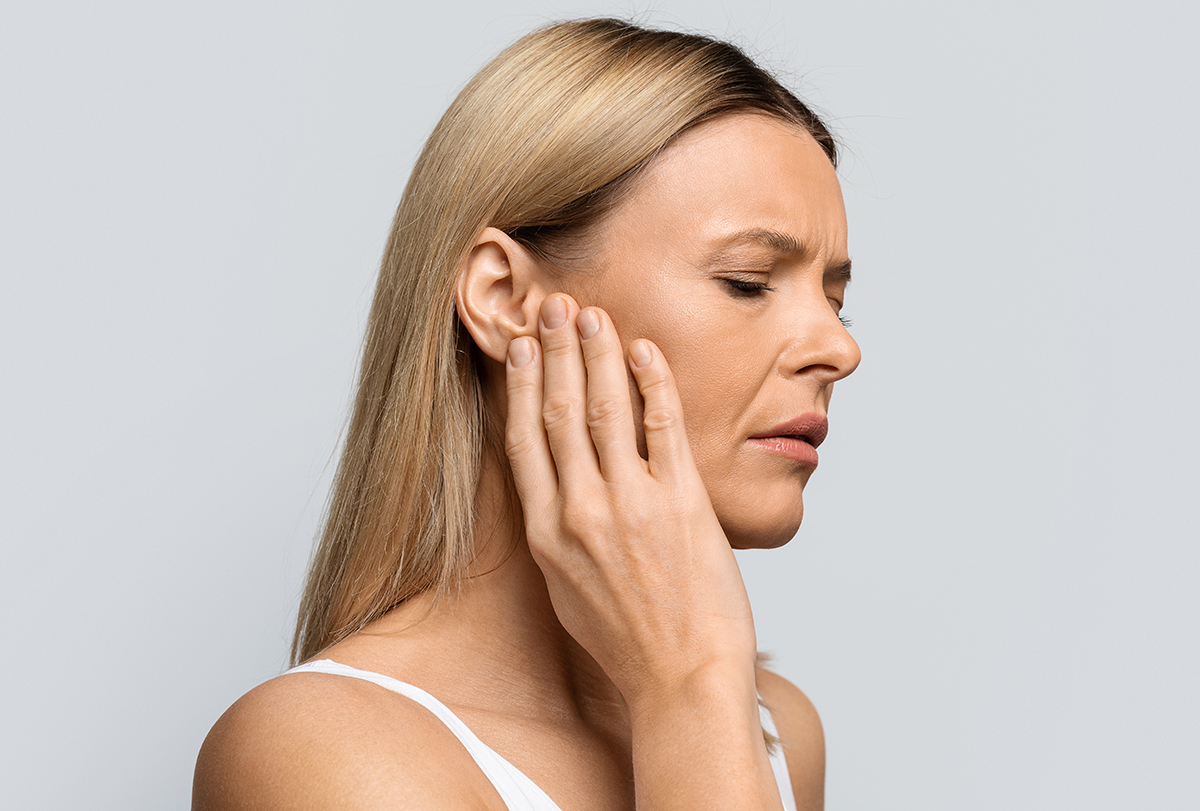
The good thing is that your ears naturally produce waxy secretions that keep this fluid from penetrating deep into the ear cavity and causing serious damage. Earwax has a thick and impervious texture, which makes it an effective barrier against incoming fluid.
The water trapped inside the ear usually clears on its own, but it can increase the risk of infection for as long as it stays inside. The warmth and moisture inside the ear cavity create the perfect breeding ground for bacteria, which can pave the way for ear infections.
Moreover, if the condition persists for a long time, it can cause inflammation in the eardrum, difficulty hearing, and cyst formation, among other complications.
So, it is better to adopt tried-and-tested measures to dry out your ear cavity as soon as possible.
Symptoms of Fluid Buildup Inside the Ear
Getting water in your ear usually results in the following symptoms:
- Muffled hearing in the affected ear
- A feeling of blockage in the affected ear
- Slight pressure in the affected ear
- Itching inside the affected ear
- Fluid discharge from the affected ear
- Signs of ear infection may include – pain inside the ear that may radiate to the neck, face, or head, excessive drainage from the ear, partial blockage in the ear canal, redness in the ear, and fever
How to Get Water Out of the Ears?
Here are some safe and simple methods to drain out the water collected inside your ear.
1. Tilt your head
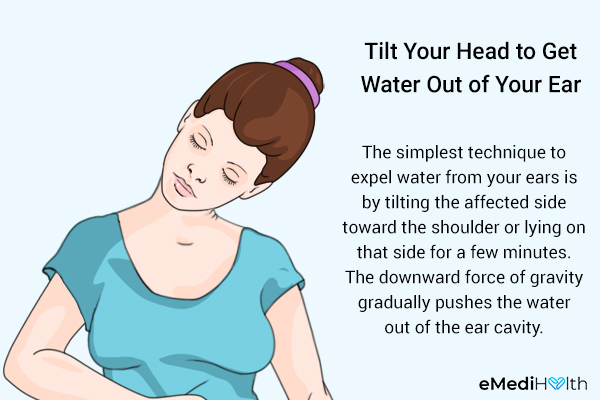
The simplest technique to expel water from your ears is by tilting the affected side toward the shoulder or lying on that side for a few minutes. The downward force of gravity gradually pushes the water out of the ear cavity.
If that doesn’t work, gently tug at your earlobe, and then jump up and down with a little speed. (1)
2. Form a natural vacuum
Tilt the affected ear downward and tightly cup it with your hand to create a vacuum inside it. Move the cup-shaped hand toward and away from the ear opening to create a suction pull, which will help draw the water out.
Do this for a few minutes, and then remove your hand from the ear. Keep your head tilted sideways until the water comes out.
3. Use a hair dryer

A hair dryer releases hot air, which can help evaporate the fluid collected inside the ear. However, you need to use it carefully because the excessive heat can end up damaging the delicate skin in and around the ear. (1)
Set the dryer on the lowest or cool setting, and hold it a few inches away from the ear opening.
Lightly stretch out your ear lobe with the other hand to expand the ear opening, and slowly move the dryer toward and away from the ear opening until it feels clean and dry.
4. Use an alcohol-based eardrop
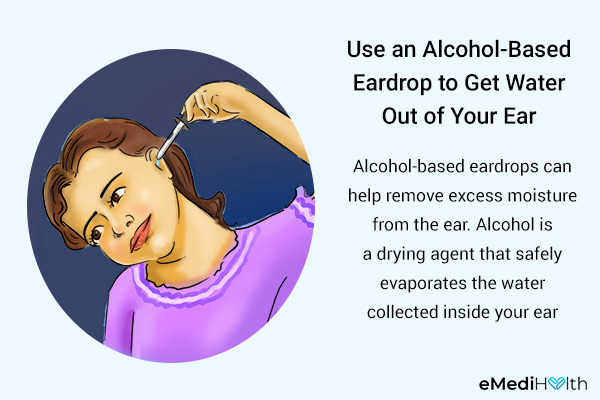
Alcohol-based eardrops can help remove excess moisture from the ear. Alcohol is a drying agent that safely evaporates the water collected inside your ear canal.
To reduce the surface tension force and allow water to flow out easily, simply add a few drops of a liquid with lower surface tension than water, such as alcohol. This will help to achieve the desired outcome. (2)
5. Try the olive oil technique
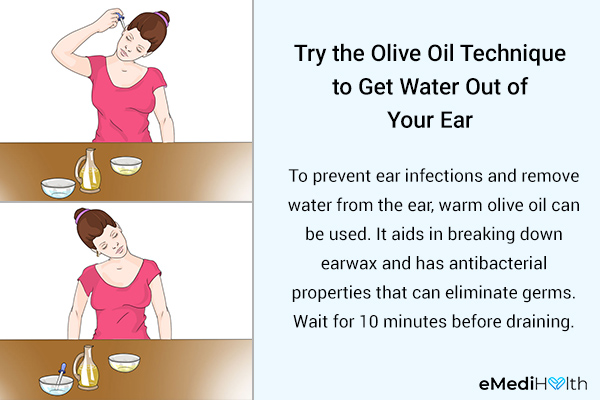
To prevent ear infections and remove water from the ear, warm olive oil can be used. It aids in breaking down earwax and has antibacterial properties that can eliminate germs.
Wait for 10 minutes before draining. (3)
6. Do the yawning technique
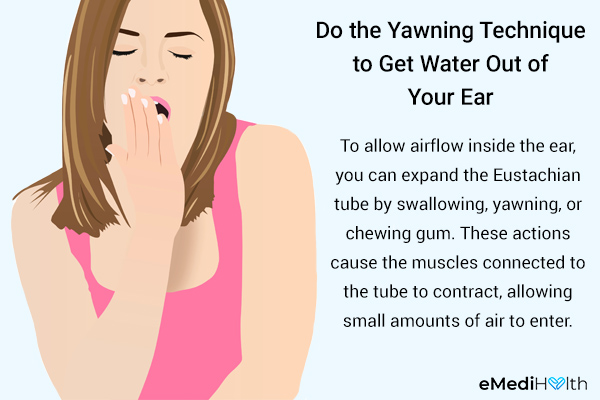
If water trickles deep into the ear canal and reaches the middle ear, it can become hard to expel.
A narrow tube called the Eustachian tube connects the middle ear to the upper part of the throat behind the nose, but it remains closed all the time. (4)
To allow airflow inside the ear, you can expand the Eustachian tube by swallowing, yawning, or chewing gum. These actions cause the muscles connected to the tube to contract, allowing small amounts of air to enter. (5)
This ventilation will help dry out the moisture collected inside. Plus, the opening of this passage will make it easier for the water to drain out of the middle ear.
7. Do the Valsalva maneuver
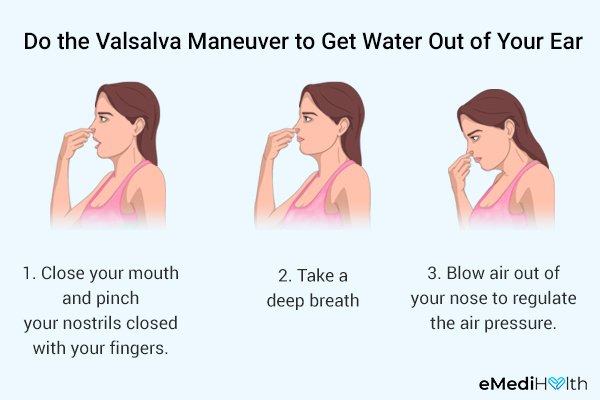
The Valsalva maneuver helps open up the Eustachian tube to facilitate drainage of fluid from the middle ear down the back of your throat.
To perform the Valsalva maneuver, close your mouth and pinch your nostrils closed with your fingers at the same time. Exhale through your closed nose until you hear a popping sound, which indicates that your Eustachian tubes have been opened. (6)
8. Perform steam therapy
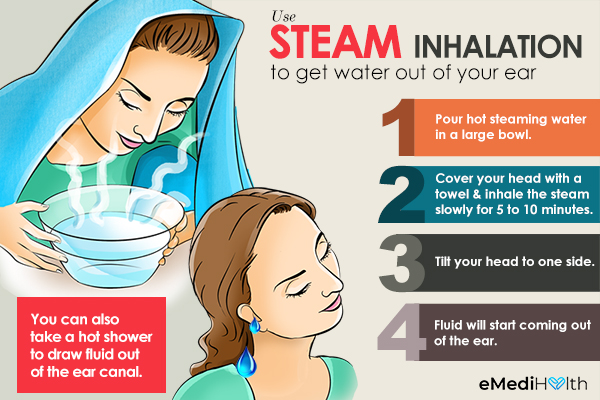
Steam inhalation is another safe and easy way to eliminate fluid buildup from the middle ear. The gentle heat opens up the Eustachian tubes, allowing the water to drain out naturally.
To do steam therapy at home, lean over a steaming bowl of water but keep your face at a safe distance to avoid burns. Put a large towel over your head and the bowl to trap in the steam. Breathe in deeply for about 10 minutes.
Alternatively, you can take a hot shower or a steam bath for the same effect. (7)
What Not to Do When Removing Water From Your Ear?
- Don’t use your finger, cotton buds, or anything else to remove the water. This could lead to an infection or even damage your eardrum.
- Don’t push your finger, ear swabs, or any other sharp object inside your ear to wipe out the fluid. The forceful insertion of such foreign objects can end up damaging the delicate inner lining of the ear and may even rupture the eardrum. Plus, it will only push the fluid deeper into the ear canal. Moreover, these objects may carry germs that will get transferred to the ear canal and cause an infection.
- Avoid putting anything in your ear without consulting your GP, pharmacist, or audiologist first.
Does Vigorously Shaking the Head to Remove Water From the Ear Cause Brain Damage?
Yes, vigorously shaking your head to remove water from your ear can cause brain damage.
According to a study conducted by researchers at Cornell University and Virginia Tech in the United States, trapped water in the ear canal can cause infection and damage to the brain. The study was conducted experimentally using glass tubes and 3D-printed ear canals. It was found that vigorously shaking the head to remove trapped water can lead to brain damage in children.
The researchers recommended an alternative solution of using alcohol or vinegar drops to lower the surface tension force and allow the water to flow out. (2)
Prevention Against Fluid Getting Inside the Ear
Here are some precautionary steps to prevent fluid from getting inside the ear:
- Wear a shower cap when bathing.
- Lightly stuff a cotton ball in each ear while applying hair spray or hair dye.
- Wear earplugs or a swimming cap when you go into the pool or a water body.
- Dry yourself properly after bathing. When there is water in the ear canal, do not put any eardrops, but if water gets stuck in the ear then you can try ear drops and the methods mentioned above.
- Make a habit of keeping water, soap, and shampoo out of your ears when showering or bathing.
Final Word
Water trapped inside the ear tends to drain out on its own after some time, but it can trigger several discomforting symptoms while it stays inside.
The above-listed remedies can provide instant relief from this condition. They help dry out your ear cavity quickly to reduce the risk of infection and other complications.
However, you must visit a doctor if the condition doesn’t improve even after 2–3 days or if you develop signs of infection.
- Was this article helpful?
- YES, THANKS!NOT REALLY


